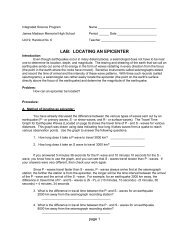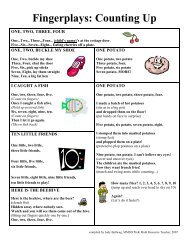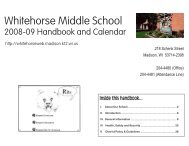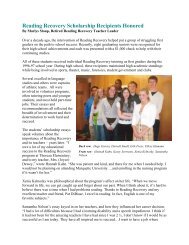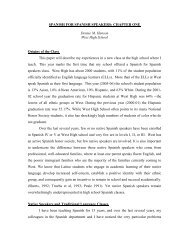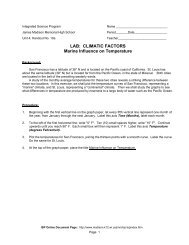The Final Report - Malcolm Shabazz City High School, Madison WI
The Final Report - Malcolm Shabazz City High School, Madison WI
The Final Report - Malcolm Shabazz City High School, Madison WI
You also want an ePaper? Increase the reach of your titles
YUMPU automatically turns print PDFs into web optimized ePapers that Google loves.
Decision Item #22:Student Impact:Strategic Priorities:Board Priorities:Effectiveness:ELIMINATE SELECTED NURSE FUNCTIONS AND REDUCEALLOCATION ACCORDINGLY (cont.)<strong>The</strong>re is no student impact of discontinuing nursing services to staff. Ifthe nurse’s role as health educator were eliminated, there would be anincreasing requirement for teachers to teach health related classes.Currently, teachers can request that a nurse teach health relatedclasses (the most common request being human sexuality). If nurses nolonger provided this function, teachers would be required to teach theseclasses. <strong>The</strong>re is no data to suggest that health courses are moreeffective when taught by a nurse than when taught by a regular teacher.Nurses’ functions are linked to the strategic priorities of student supportand home community partnership. <strong>The</strong>re is no direct link betweeneliminating the identified functions and strategic priorities.Nurses’ functions that focus on improving student health are directed atimproving attendance, which is a key Board priority. <strong>The</strong>refore, thosefunctions were not identified as options for reductions. However, there isno link to Board priorities for the role of nurse as health educator (ifteachers provide instruction) or as provider of nursing services to staff.No data were provided to suggest that nurses are better healtheducators than teachers.Other Considerations: This analysis presumes that eliminating functions and the correspondingdemands on nurses’ time can lead to a reduction in overall allocation ofnurses by a corresponding amount. It should be noted, however, thatthere are likely operational differences in how nurses spend their time,based on the needs of the schools to which they are assigned.<strong>The</strong>refore, this reduction in functions and total nurse FTE’s allocated toschools should be accompanied by a reexamination of the allocationformula to ensure continued appropriateness.Although there is no uniform national standard for nurse student ratios,the National Association of <strong>School</strong> Nurses recommends the followingratios:1:750 general populations1:250 mainstreamed populations1:125 severely handicapped populations<strong>The</strong> current ratio of nurses to students is 1:950. A reduction of 2.0 FTEwould yield a ratio of 1:1040. While this is higher than professionalassociation standards, it is important to note that the District also has26.6 nurse assistant FTE’s to assist in service delivery.<strong>The</strong> principal survey results provide additional information on theappropriateness of nurse allocations (prior to any adjustments). Whenasked to rank the importance of over 20 allocations, principals at highschools, middle schools, and elementary schools ranked nurses as 3, 6,and 4, respectively (with one being the most important).Virchow, Krause & Co. LLP Page 109March 11, 2002



